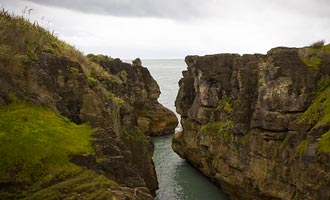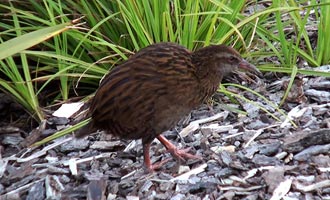
Pancake Rocks, a Journey Back in Time.
Please contact us and we will help you to organize your trip! It's free and without commitment.
- Read the post
- Details
- Advices
Schedule of the Visit.
- 1A Day at the Pancake Rocks.
- 2Unexpected Meeting with a Weka.
- 3The Pancake Rocks Beyond Imagination.
- 4Spectacular Geysers!
- 5Exploring the Marine Caves of the West Coast.
- 6Activities in the Paparoa National Park.
- 7A National Park Just for You!
A Day at the Pancake Rocks.
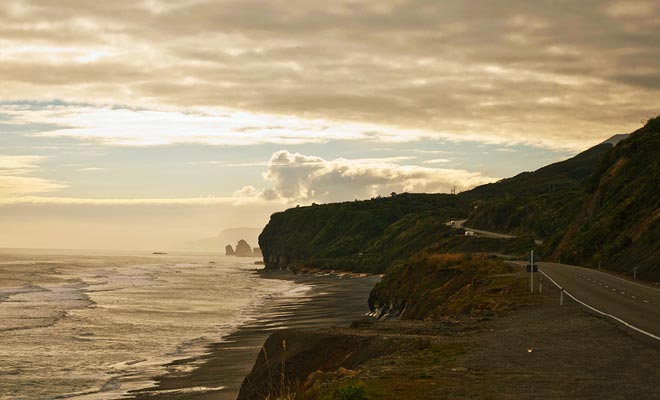
The road that runs along the west coast is beautiful.
Today, our journey leads us to the famous Pancake Rocks, in the Paparoa National Park of New Zealand.
Even if you travelled a lot in your life, you'll be surprised to discover the amazing relief of this South Island coast.
In 2017, we decided to include the Pancake Rocks in our ranking (as well as the Moeraki Boulders).
We will take the road along the West Coast from Greymouth.
You can expect a journey of great beauty, with the Tasman Sea on one side, and a dense and wild vegetation on the other.
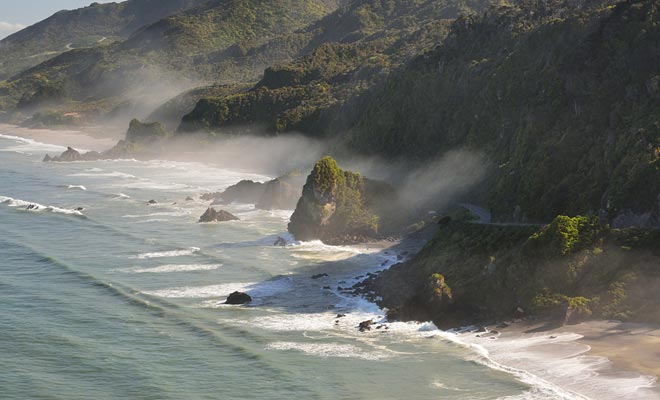
Meybille Bay is just a short drive from Pancake Rocks.
The air is still fresh this morning before getting in the car. In New Zealand, the weather can change several times a day.
Once you understand that, you just pack a change of clothes and you can stop worrying about the weather. But New Zealand also provides great advantages because as usual, there is not a soul on the road (one may wonder if the traffic-jams exist in this country).
The only challenge of the trip will be to resist the temptation to stop every five minutes to take pictures.
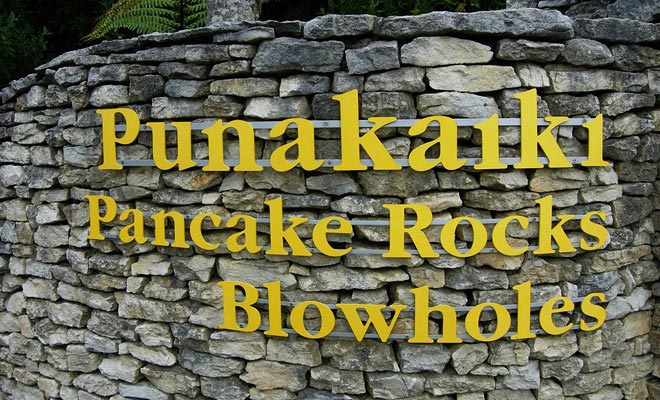
Welcome to Punakaiki and its Pancake Rocks!
The key is to come at sunrise to fully enjoy the show. But that's not the only reason that led us to hit the road so early. Most guides focus exclusively on the Pancake Rocks' visit. But you will discover that this wonder of nature is far from being the unique attraction in the region.
Unexpected Meeting with a Weka.
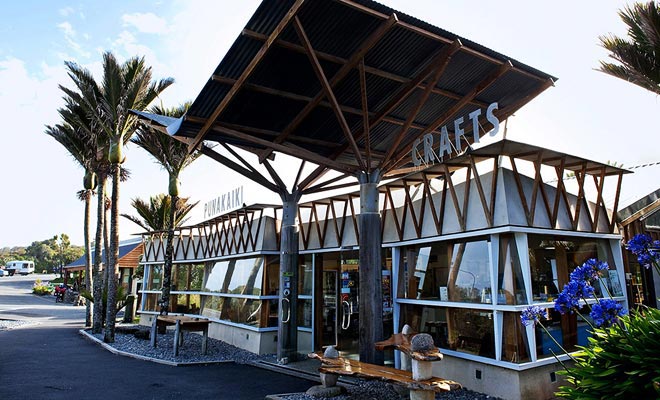
The souvenir shop is quite original.
Punakaiki is a tiny village with no special charm. There is no reason to linger for now. Let's focus on the essential and locate the starting point of the hike.
Near the car park where we parked, there is a path to reach Dolomite Point where you can admire the Pancake Rocks. At this early hour, the iSite is not open yet, but I know the way. The information panel announces a 15 minutes' walk.
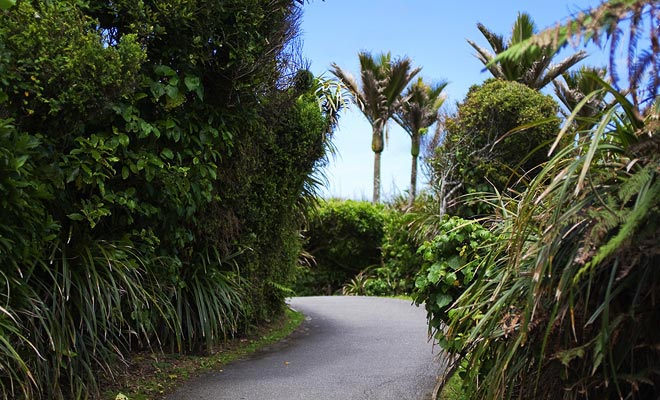
The trail that leads to Pancake Rocks is a health walk.
On our way we will discover that the vegetation of the forest is full of surprises.
The nikau for example, is a palm tree that should not exist at such a low latitude. Moreover, the peaks of the Alps which can be seen in the distance are snow-covered. But we are actually in what is called the New Zealand's bush.
The region benefits from a unique microclimate due to the presence of a warm air current from Australia.
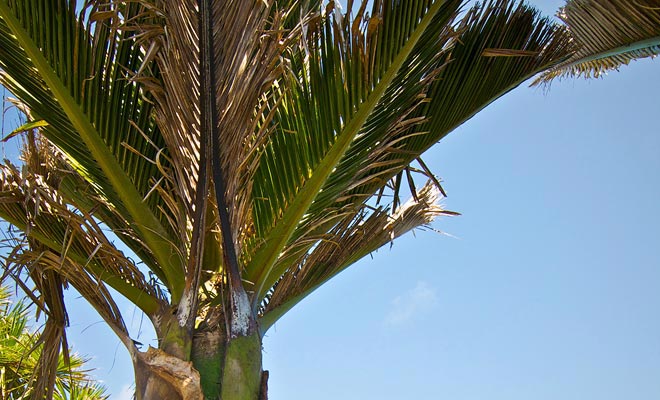
Nikau palm trees should not exist at such latitude.
Please allow me to open a short parenthesis to specify that Kiwipal could have been named “Wekapal”. The weka came close to be chosen instead of kiwi to represent New Zealand. Both species have in common to be flightless birds.

The Weka almost supplanted the kiwi as mascot of the country.
The intrepid weka from New Zealand is able to jump, move fast and even swim.
Not bad for a bird! And this great traveller is known to defend his territory and his babies with great courage.
However, if the weka is stubborn, pugnacious... he often finished in a cooking pot.
The ancient Maoris considered this bird as a big chicken, and even sometimes as a pet.

The Weka can travel for miles to return on its territory.
Let's close the parenthesis. The weka that crosses the trail before us does not show the slightest fear. He just wags his tail to express his annoyance. At this early hour, he was not expecting to be disturbed. His walking style, sometimes hesitant, sometimes determined is fun to watch.
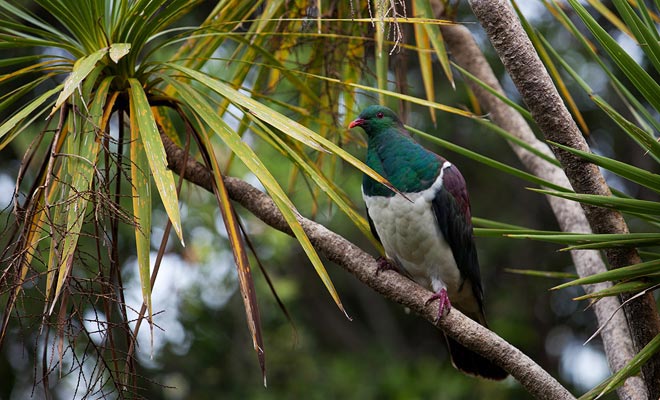
The Kerukeru has few predators, which explains its overweight.
The weka has no wings, so who is making such noise in the trees? The kerukeru, a wood pigeon is easy to spot in the branches.
At least this one can fly, but he had another problem. The Maoris hunted this bird and used its shimmering blue feathers to adorn their coats.
You can learn more by reading the information boards well disposed on the path.
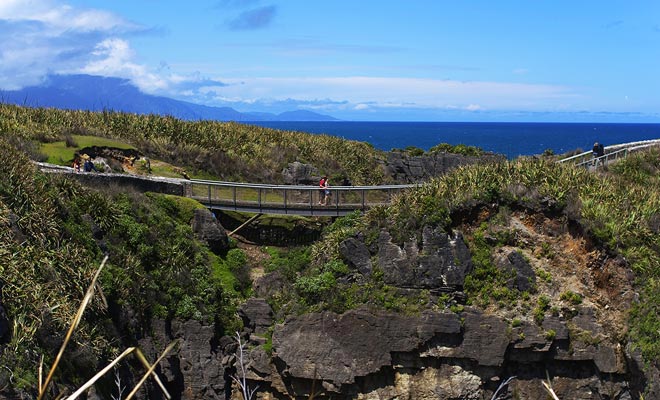
The sound of the waves resounds against the rock.
There are even benches to sit on. But this is not the right time to rest, because the sound of the waves seems very close. There are only a few meters to cross to get out of the forest and reach the Pancake Rocks.
The Pancake Rocks Beyond Imagination.
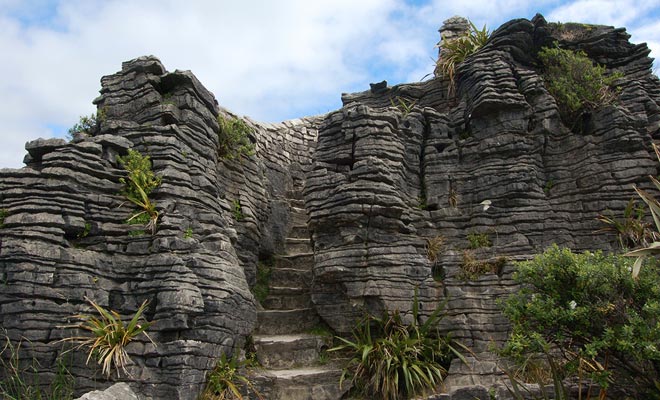
A staircase was sculpted in the rock.
And here we are at the Pancake Rocks, with the advantage of being the first on site. The show fit our expectations and even more.
I doubt that the name "Pancake Rocks" was invented in New Zealand. Personally, I would have chosen to call them millefeuille in reference to the famous French pastry The cliffs that overlook the sea are made of dozens of limestone layers.
Most of them are only a few centimeters thick. During sunrise, such stones seem literally to glow.
There are many platforms where you can take beautiful photos.
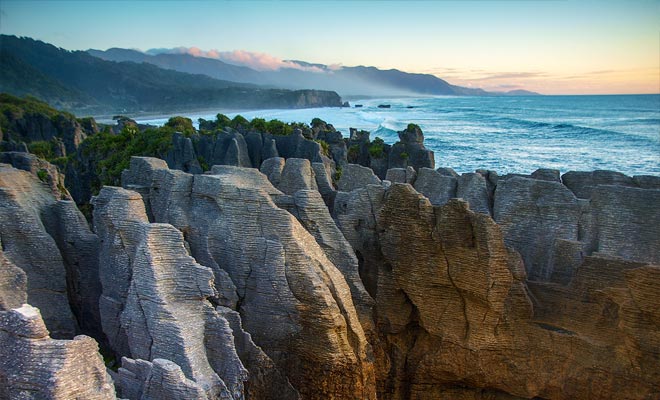
It looks like a stack of thin layers of rock.
It is difficult to imagine that nature could produce such a beautiful landscape.
It is difficult to accept the fact that humans didn't create this strange stack of rocks. In fog, you might have considered them as the ruins of a lost civilization.
Many cliff pieces broke away with time. The wind and acid rain have sculpted the relief.
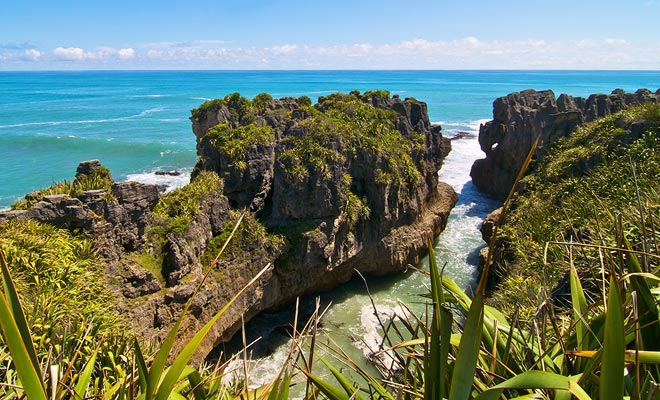
Erosion has sculpted the landscape, but that does not explain it all ...
30 million years! This is the incredible amount of time it took to give birth to these cliffs.
A number that may cause vertigo. During millions of years, sediment depositions and dead marine creature’s decomposition created the rock layers.
However, the scientific explanation of the phenomenon remains incomplete presently.
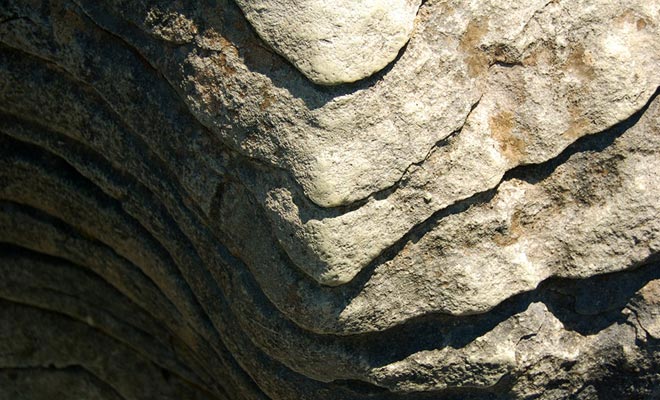
Each layer corresponds to a deposit of sediment.
The different accumulated strata should have remained hidden beneath the surface. But earthquakes have raised the earth's crust. If you observe the rock carefully, you will realize that its colours change by periods.
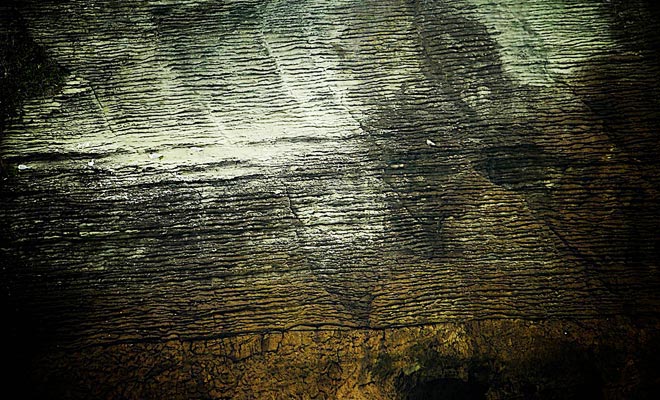
The oldest layer dates back to 33 million years.
The Pancake rocks are like these trunks where the rings allow to estimate the age of the tree.
Each stack tells a part of the Earth story. The limestone layers allow us to go back in time to reach the Oligocene epoch.
A period that coincides with the second mass extinction since the dinosaurs disappeared.
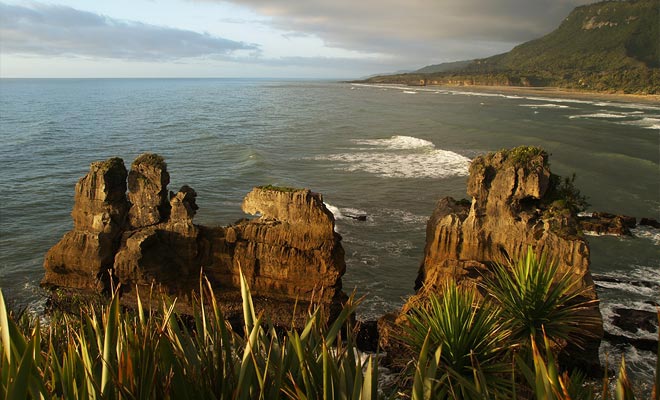
The Tasman Sea has sculpted magnificent reefs.
The beach which is empty extends to the horizon. The powerful waves of the Tasman Sea collide with the cliff and sculpt the rock. We arrived at high tide and you'll discover soon the real reason of our presence here.
Spectacular Geysers!
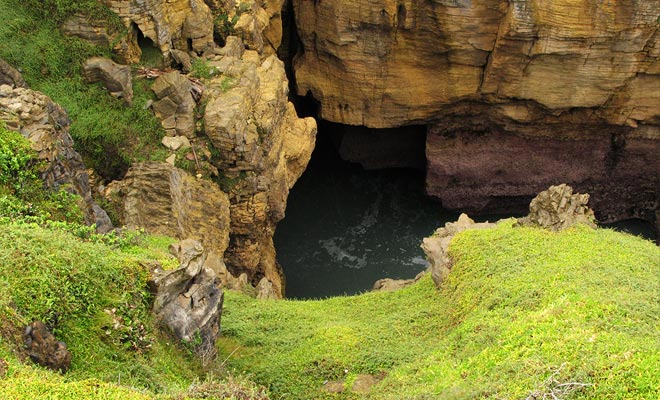
Erosion has dug underwater caves.
While crossing the bush, I almost believed to hear the roar of a lion. The coast receives the full brunt of the waves, rushing inside narrow cavities.
Sea water is propelled along the vertical chimneys carved into the Pancake Rocks.
This phenomenon creates true geysers called blowholes by the locals!
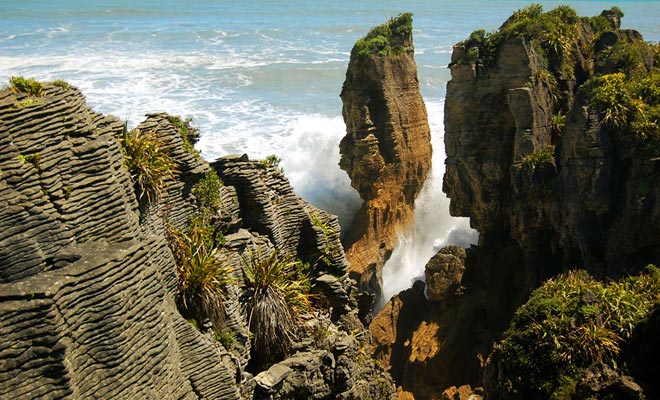
The waves sweep into the narrow cavities ...
The foam is projected several meters high and falls back on the Pancake Rocks. The sight is particularly impressive, and the phenomenon also gives birth to ephemeral rainbows.
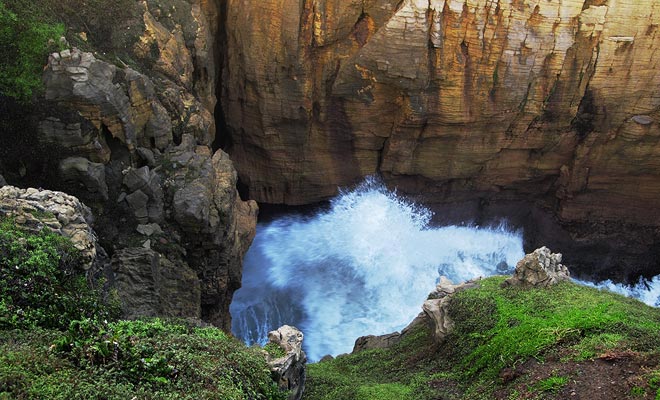
The pressure is such that the water gushes forcefully!
One should consider wearing a wax before coming. This will prevent you from being soaked like me the first time! But I must confess I was far too close to a blowhole. I also recommend that you protect your precious camera against moisture to avoid blurry pictures and most of all to keep it intact for the rest of the trip.
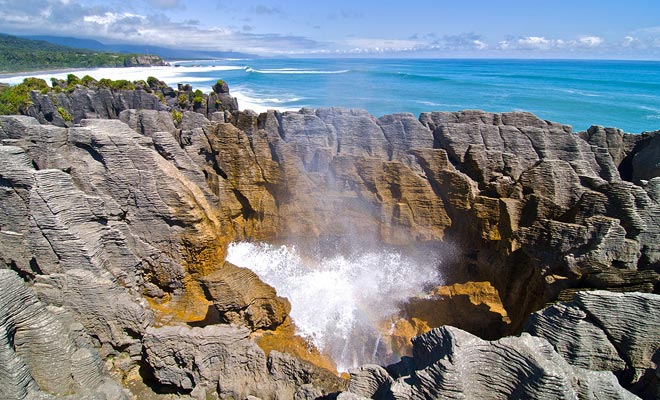
Water vapor rises to the surface ...
The blow holes are not always active. Most guides outline that you must come at high tide to fully admire them, and I confirm this condition. But that is not enough sometime, because other factors are essential.
It is very important that the waves hit the rock at full strength. So, you should plan your trip to arrive one hour before or after the high tide.
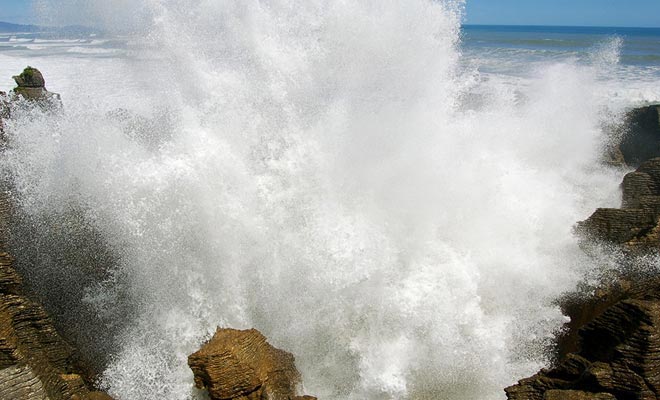
Then a real geyser forms and explodes!
You will increase your chances significantly, but there is a final ingredient you can't control! When it blows strongly, the wind creates strong waves (this is a dangerous coast and nobody swims here). And the roughest the sea, the strongest the blowholes will be.
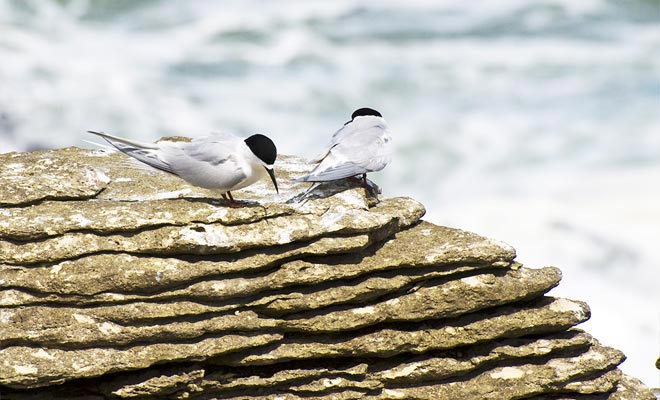
The deafening din does not disturb the terns.
The thundering roar of the waves that resonates in marine caves is quite frightening even when you know what is happening.
It does not seem to bother the white-winged terns. This endemic species of bird of New Zealand is not even frightened by the presence of man. The terns are nesting in the vegetation covering the Pancake Rocks.
You could easily spend hours gazing at the landscape.
You may have spotted the presence of caves carved into the rock. This will be our next step of the journey. But for now, the tide is temporarily blocking the beach access.
We have nothing to do, so we'll rather enjoy a hot coffee in a café while waiting for the low tide.
Exploring the Marine Caves of the West Coast.

The Pancake Rocks Cafe is not fantastic, but has Wi-Fi.
The Wild Coast Cafe is on the edge of the road. It serves pancakes (what a surprise ...) and breakfasts without much originality. Not so bad, in my opinion.
Enjoy the Wi-Fi for a $3 fee to send some pictures to your relatives. If you are starving, I would rather recommend the nearby tavern where you will also find a pool table to kill the time. Meanwhile, the tide began to descend and it is time to go on an adventure!

A small coffee to get in shape and we leave ...
If you enjoyed pirates’ stories when you were kids, you will love the Punakaiki Cavern Track. The departure point is just 500 meters from the car park. Over time, erosion has led to the collapse of fragile rock. Many caves were formed that we can explore today at low tide.
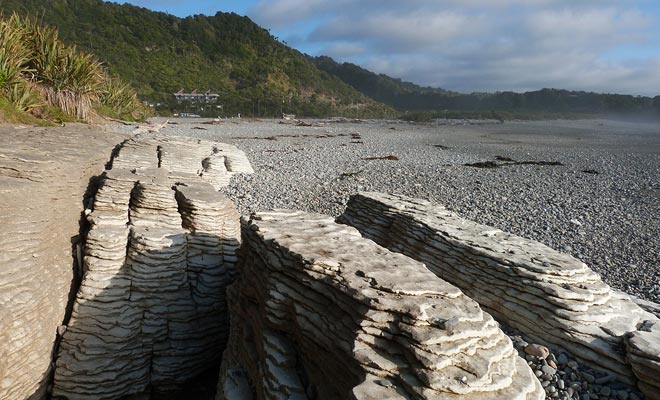
The beach is finally accessible at low tide.
A long wooden staircase provides access to the beach. The cave is dark and it would not be reasonable to advance further without lighting.
There is no other choice but to return to the car park to pick my flashlight. Once inside the marine cave, you must carry on carefully because the rocks can be slippery.
You must wear good shoes! The torch is necessary to illuminate and admire the high arch of two meters.
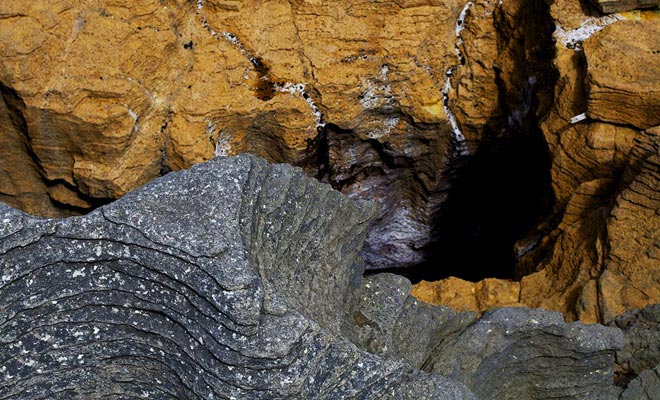
Some marine caves are still unexplored.
The sound of the waves resonates all around us and the wind whistles. This is a very original experience and quite unexpected. This place is easily accessible and well sign-posted, but you must be careful anyway.
Some caves are home to glowworms, others have never been completely explored.
One just needs to listen to his common sense!
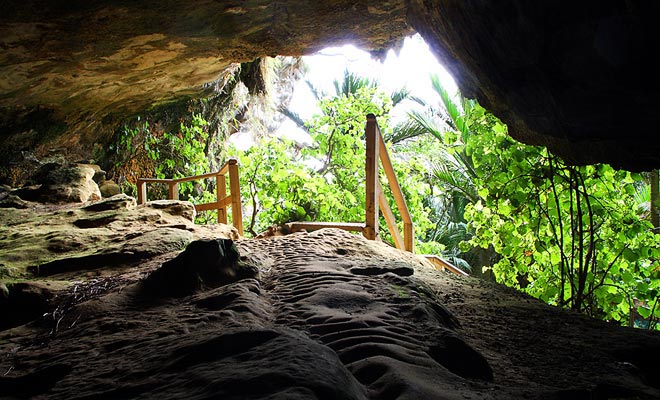
The cave of Punakaiki Cavern Track requires a flashlight.
Once back at the open air you can walk along the beach to reach the Pancake Rocks' cliffs.
The Hector's dolphins (the smallest dolphin species) can sometimes be spotted along the coast. But do not expect to go swimming here because the sea is too damn rough, even for experienced swimmers.
If you enjoyed visiting the caves, please remember that there are many places in New Zealand where you can admire glowworms, the most famous one being Waitomo Glowworm Caves.
So far we were focused on the coast, but the subtropical forest holds many mysteries as well.
Activities in the Paparoa National Park.
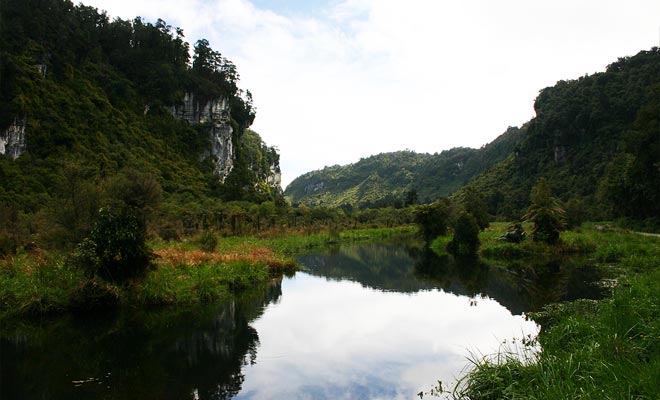
The Paparoa National Park is still unknown to the general public.
The Information Center has a permanent exhibition on Paparoa. The smallest national park in New Zealand is also the least crowded by tourists. Yet it is one of the most interesting.
The park covers 38,000 hectares (380 km2) of rainforest. Most visitors are unaware that there are many activities on site, most of them being among the bests in New Zealand.
In the end, do not take my word for it! These adventures will be covered in a separate article. I will not go into detail now. But to save you time, I'll still give you an overview of the main activities.
Even if you are running short of time, you cannot miss the Truman Track (20 minutes return).
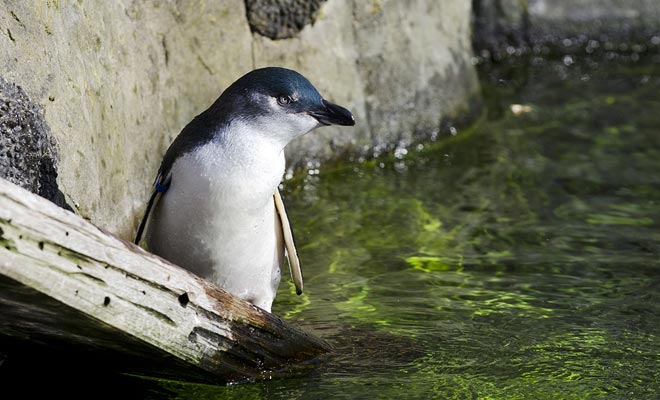
The blue penguins occupy the beach for much of the year.
The trail starts along the SH6, 3 km from the Information Center. It winds through the palm trees to reach the coast and a nice waterfall.
The beaches are to be visited at low tide if you want to explore the marine caves.
Anyway, you cannot swim here, unlike the blue penguins living there between August and February.
To observe them without disturbing, you should plan your visit at dawn or at sunset.
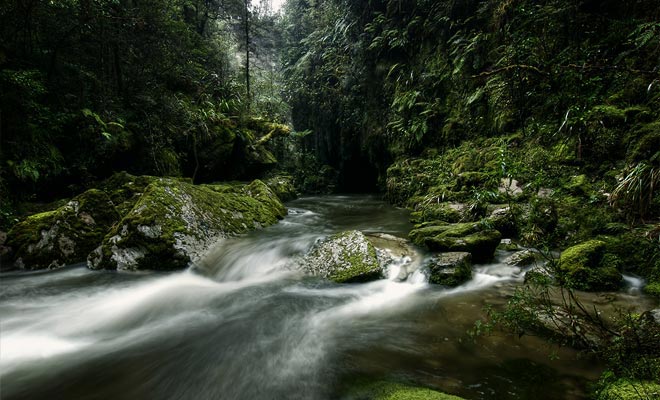
It is best to be accompanied by a guide in the park.
Visiting the Pancake Rocks beach can be done on horseback. The Punakaiki Horse Treck takes place mostly in the subtropical forest, before reaching the beach and cliffs. The complete tour lasts 2 hours and 30 and can fill your morning.
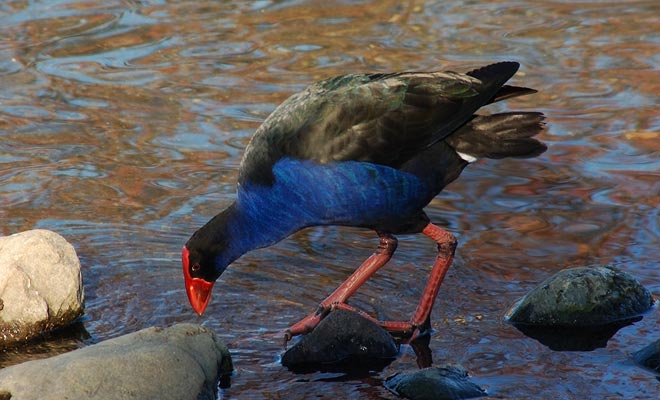
The pukeko has a bright blue plumage and a red beak.
The equipment is provided and beginners are welcome. This is also an opportunity to observe many species of birds, including the famous pukeko (very photogenic with his bright blue plumage and his red beak).
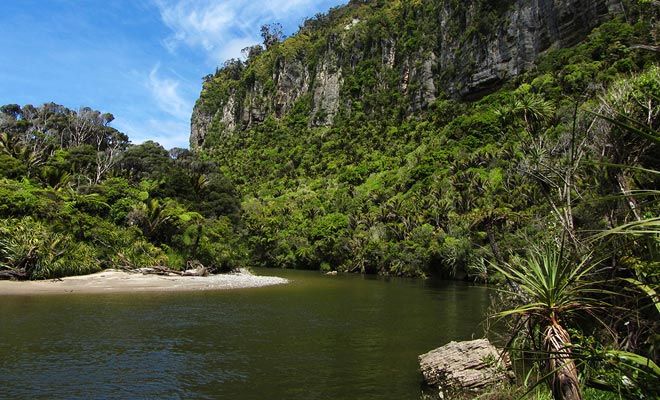
The landscape would have its place in a film of Jurassic Park.
The Porari river is a must to go kayaking, and it is especially great for beginners, because its waters are particularly quiet with low currents. This is a great moment to share with your family.

The canyon is spectacular!
After a 1 km navigation, you reach a canyon worthy of Jurassic Park. It only lacks dinosaurs! The tour does not cost much (70 $), lasts 2 hours 30 minutes and is very rewarding.

The ancient route of gold seekers crosses caves.
Finally, amateur speleologists will not miss the "Fox River Tourist Cave" full of stalagmites and stalactites.
They will borrow the old route of the gold diggers. Please allow 2 hours (round trip) or more depending on time spent on site. With good shoes, flashlights and your common sense, everything should go very well. But an experienced guide may also join you (ask at the iSite).

The Fox River Tourist Cave can be visited with a guide.
If you are a great walker and never afraid by long adventures in forest, the Inland Track was meant for you.
This hike takes two or three days to complete and covers 25 km.
Before departure, a visit to the Information Center (iSite) is crucial.
Some rivers may overflow, and the hiking paths (once used by gold miners in New Zealand) are modified according to circumstances.
Maps are updated regularly, which explains why they are not given for free (the cost is only from 50 cents to a dollar).
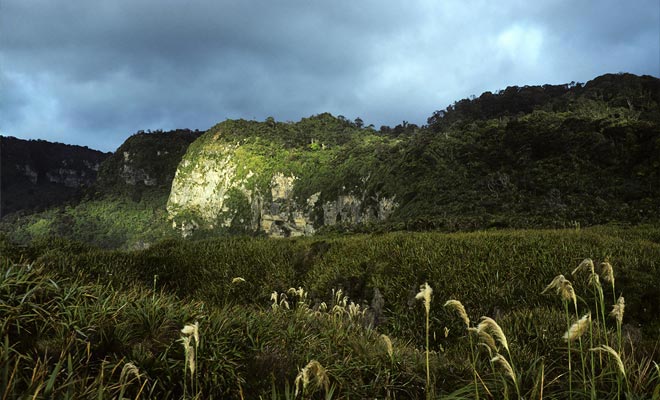
The Paparoa National Park is full of activities.
Most activities are calibrated to last two or three hours max. You should organize yourself according to the tides to fully enjoy the Pancakes rocks. But among the beaches, caves, or the long forest paths to explore, you have plenty of choice!
A National Park Just for You!
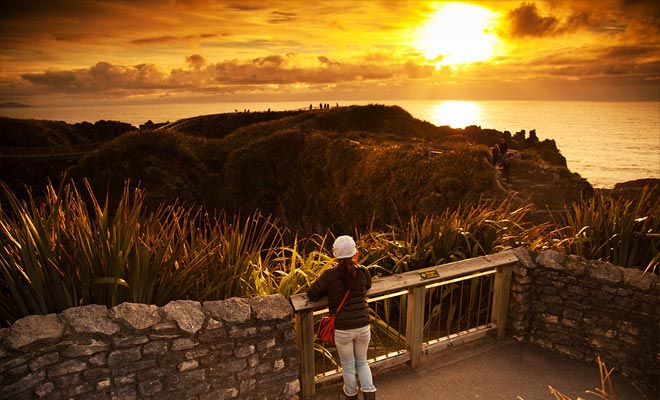
The sunset on the Pancake Rocks is magical!
The Pancake Rocks can be crowded during the high season. It is especially the big tourist coaches that you should fear (how is it really possible to enjoy a country this way?).
As everywhere else, you just need to organize yourself to avoid rush hours. By mid-morning or late afternoon, attendance remains very reasonable.
Bad weather can even be a good news. There would be fewer tourists, and a tempest would even strengthen the power of the blowholes!
Of course, I'm not going to wish for rain, but a bad weather won't ruin the trip for sure!
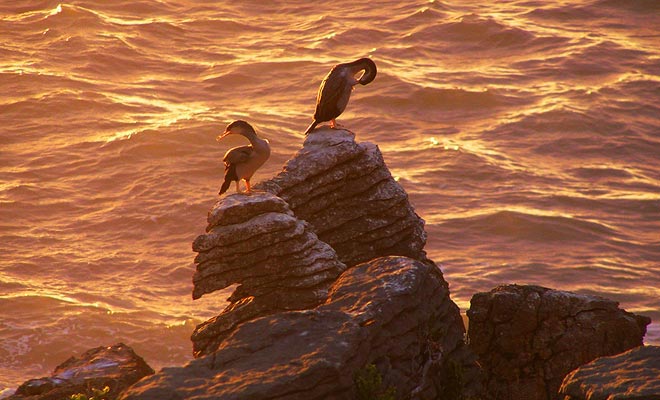
Each layer of rock represents millions of years.
Access to Dolomite Point is almost too well maintained!Particular attention was given to safety, with the presence of low stone walls. Access is forbidden to animals even if kept on a leash. Outside of the path, there are many crevasses and the cliffs are very steep. However, as long as you stay on the track, there is nothing to be feared.

Follow the safety instructions and don't cross barriers.
If the whole Paparoa Park is so nice to explore, it's mostly because the hiking trails are maintained by volunteers. So, if you enjoyed your visit (I don't see how the opposite could be true...) please remember to drop a few coins in the “Donation Box” (there are many businesses based on volunteering in New Zealand) at the iSite.
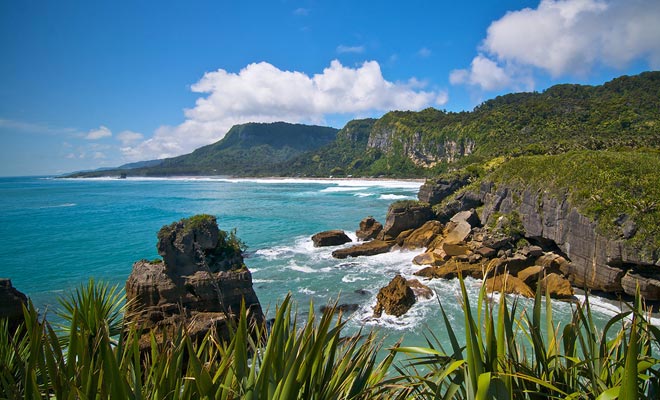
The views are breathtaking.
When one considers that some people just stop here to eat ice-creams! The Paparoa National Park was opened to the public in 1987, yet it remains relatively unknown, which is finally a good thing for us...
I often had the feeling to have the forest or the infinite beaches just for me.
Alas, if you are on your way to Fox Glacier or the Franz Joseph, you may not have enough time to go hiking.
But the exploration of caves on the beach will only take a moment of your day.
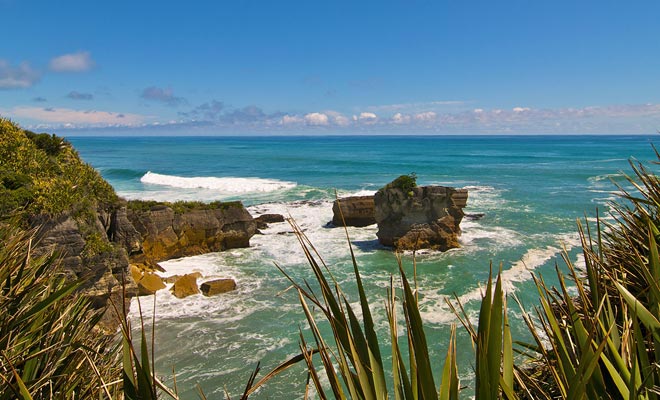
Such a landscape deserves more than a 20-minute break.
However, if I managed to convince you to spend a night there, be aware that the accommodation options are quite limited.
At Punakaiki, you'll get the best value for your money. But there are only few hotels on location, and your options are limited between cheap or luxury accommodation.
I have given you a small taste of the National Park. There are so many places to explore where man has never set foot yet.
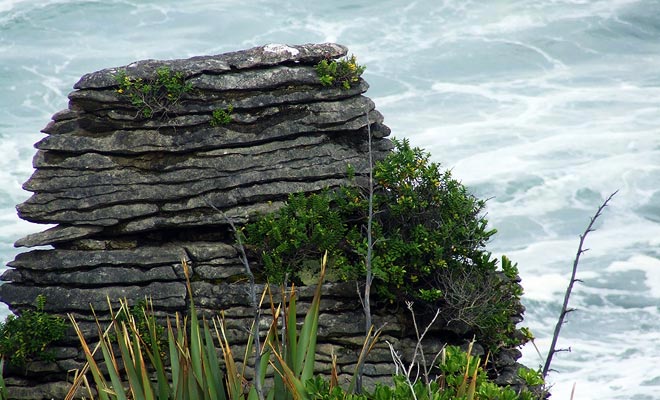
Do not forget to send us your photos!
Before you go, please allow me to introduce our friend Ben. He is the official mascot of Kiwipal but is above all a true expert who has travelled New Zealand, far and wide for many years. I always give him the mike when it's time to answer practical questions. If you enjoyed our help, please send us some pictures or videos of your trip: the most beautiful creations will be published on Kiwipal to illustrate our articles.


Questions & Answers.

What can I do for you? I love the Pancake Rocks, but this is a secondary attraction of the Paparoa National Park after all... Try to allow a half day to include at least one trek in the area.
- All topics ... 28 answers in total
- Excursion to the Pancake Rocks 8 answers
- Practical Information 6 answers
- Other Excursions in the Park 3 answers
- Transports 3 answers
- Weather and Tides Schedule 3 answers
- Restaurants 3 answers
- Accommodation and Camping 2 answers
Excursion to the Pancake Rocks
- Can I access the Pancake Rocks in an armchair?
The main part of the walk is suitable for people with reduced mobility. The soil is regular and stable. Most viewpoints are accessible. Only the end of the course includes some steep steps impossible to cross in a wheelchair.
- How long is the walk to Pancake Rocks?
On paper, it takes only 30 min to go back, but one must add the time to spend on the spot to enjoy the view and take pictures. Not to mention the possible encounter with Wekas.
- Is the excursion to Pancake Rocks difficult?
I consider it as a walk for beginners. There are benches for sitting. A few steep and uneven steps on the end of the trail can hinder some people.
- Is it free?
The tour is free as well as the hikes you can do without a guide or equipment. Think about making a small donation in the generosity box provided near the iSite.
- Is it crowded with tourists?
It is a very popular and easily accessible visit. In summer, many tourist buses stop on site, but usually do not stay long. This is acceptable, but the ideal is to come early or late in the day. As far for the excursions, most travelers are even unaware of their existence, and you will often have nature for you all alone.
- Is there a risk of getting wet?
If it does not rain and you come at low tide, there is a low chance to get wet. When the tide rises, and the wind blows, a good wax is recommended. The blow holes generate foam geysers, and the moisture disperses into the air. With a strong wind, the umbrella is rather to avoid. Be careful that your camera is not wet during the trip.
- How to dress?
You are in front of the Tasman Sea. Even in good weather, it is always cool in the morning or in the evening. In New Zealand, it is necessary to provide light clothing that can be donned or removed depending on the weather. Take a wax with you anyway.
- Is access allowed to animals?
No. Even on a leash, they could fall into the crevices on the side of the trail.
Practical Information
- Where is the Information Center?
The Paparoa National Park Visitor Center & DOC is in front of the path leading to the Pancake Rocks. Go to Punakaiki, Main Rd. Phone: (03) 731 1895 Schedules vary according to the time of year. October to December: 9 am - 5 pm, January to May: 9 am - 6 pm, June to September: 9 am - 4:30 pm
- What are the opening hours of the iSite?
Schedules vary according to the time of year. October to December: 9 am - 5 pm, January to May: 9 am - 6 pm, June to September: 9 am - 4:30 pm
- How long should we stay in the park?
Either way, the visit to Pancake Rocks can be restricted to a short one-hour stopover. But I recommend at least to add the stroll on the beach, then to the caves if the tide is low. The ideal is to spend a night on the spot to be able to do at least one of the walks of the national park of Paparoa. If I had to recommend only one activity to someone, I would choose the excursion in a kayak on the Paparoa River.
- Can you find a WiFi connection on site?
You can connect in the café near the parking lot. Access is set at $3, which is not very expensive considering the isolation.
- Can we buy souvenirs?
The West Coast Café sells souvenirs and the usual postcards. No particular reason to buy here rather than elsewhere... They also sell clothes.
- Where can we get a hiking map?
The conservation department publishes a map for sale at the information center. It will cost you a dollar. The hiking map of Croesus Track is sold separately and costs 50 cents. Suffice to say that at such a low price, you are just paying the printing. In any case, the map is essential, because it is updated regularly (the trails evolve over time).
Other Excursions in the Park
- How to organize a horseback visit?
Neil and Karen take care of Punakaiki Horse Treck from late October to early May. Schedule a budget of about $160 per person. Several excursions each day. Meet at Punakaiki, Main Rd for departure.
Telephone: (03) 731 1839
Email: info@pancake-rocks.co.nzPunakaiki Horse Treck - How to organize an excursion with Punakaiki Canoe?
A sign post at the entrance of Punakaiki indicate the location. Count $30 for a two-seater canoe (which is not very expensive).
Phone: (03) 731 1870.Punakaiki River Kayaking - How to book guided tours?
You can contact Green Kiwi Tours, they offer many outings.
Telephone: (03) 731 1843Green Kiwi Tours
Transports
- How to get to Pancake Rocks?
You have to join Punakaiki. From Greymouth it takes about 35 minutes to travel 44 km following the SH6. From Westport the journey takes 50 minutes for 56 km by taking the SH67 then the SH6. Once parked, take a 15-minute walk to reach Dolomite Point. In your GPS, you can enter this address: Dolomite Point, State Highway 6, Punakaiki, Greymouth, West Coast.
- Can we get there by bus?
The Naked Bus follows the SH6 and goes through Greymouth ($12) and Westport ($12) and stops at Punakaiki. The Intercity and Atomic Travel buses offer the same service with a few price variations. Consult their respective websites for the hours of passage.Naked busAtomic TravelIntercity
- Is there a gas station in the area?
One cannot refuel at Punakaiki. The nearest gas station is at Runanga (37 km to the south). But it would be a good idea to refuel at Greymouth or Westport instead.
Weather and Tides Schedule
- Is it necessary to come at high tide or at low tide?
Ideally, you have to come an hour before or after high tide to enjoy the geysers. But the Pancake Rocks can be observed at any time of the day. As long as the fog is not too thick.
- How to get the tide schedule?
You can find the tide schedule at the i-Site (the information center). Or check out these different sites:Punakaiki Tides schedule
- Is it necessary to come if there is a fog?
The fog masks the view off, but strengthens the strange atmosphere. When fog comes with bad weather, the result can be a rather impressive experience.
Restaurants
- Can we have lunch here?
The Wild Coast Café serves breakfasts and fish & chips ($11 to $20). It is not here that you will taste whitebait... I would rather recommend preparing your own sandwiches and ordering just a hot drink. If you are really hungry, it is probably better to visit the nearest Punakaiki Tavern (you will also find a pool table).
- Where to find the Wild Coast Cafe?
Highway 6, Punakaiki
Telephone: (03) 731 1873
Open 7/7
Winter: 09:00 - 18:00
Summer: 8:00 - 18:00 - Where to find the Punakaiki Tavern?
Corner of State Highway 6 & Owen Street
Punakaiki, RD 1 7873
Phone: (03) 731-1188
Accommodation and Camping
- Can we stay there?
One would not believe it at first sight, but Punakaiki offers quality accommodation with excellent hospitality. The official website of the city presents the different lodges available.Punakaiki Lodge
- Is there a campsite?
Punakaiki Beach Camp is set on a large lawn between the cliffs and the sea. You can reach the beach on foot. Access is at Owen Street on leaving SH6. During the high season, it is often necessary to reserve his place by telephone at (03) 731 1894). Count $18 / pers for a tent with a supplement of $6 to be connected to electricity. The basic cabin costs $50. Find all the details on this page:Punakaiki Beach Camp
On the Country Map
Punakaiki's Pancake Rocks are located on South Island's West Coast.

